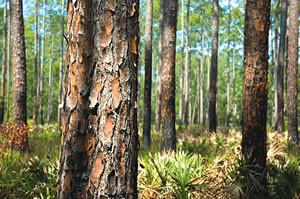SHARE:
Biofuels
Ethanol: Miracle or Mistake?
Florida is sinking millions into ethanol research and grants. But nobody is even close to making it profitable.
At present, sugar industry titan Florida Crystals burns that bagasse along with yard waste from Palm Beach County to generate electricity at its Okeelanta site, the largest biomass co-generation energy plant in North America. Gaston Cantens, Florida Crystals’ government relations vice president, says the expectation is that Ingram’s process will first refine the bagasse into ethanol. Then the part of the bagasse that can’t become fuel will be burned for electricity. Ingram’s cellulosic ethanol breakthrough first was patented 17 years ago, however, and there’s still no refinery.
 Reality Check |
At least two other researchers using state grants are working on other ways to make bagasse into fuel. But since there’s not enough bagasse to fuel Florida, state officials are banking on making cellulosic ethanol out of everything from suburban yard trimmings to wood from Florida’s forests. It didn’t get encouraging news in June when Florida agribusiness firm and land developer Alico announced it was abandoning plans to build a plant in LaBelle that would have turned yard, wood and agricultural residue into ethanol, hydrogen, ammonia and electricity. The company said it wouldn’t take the $33-million federal grant that would have helped build the plant because the risks outweighed “any reasonably anticipated benefits for Alico.”
Ethanol, meanwhile, isn’t immune from the normal hiccups that accompany any startup industry. United States Envirofuels, holder of a $7-million state grant, encountered opposition from a neighboring community to its plans to build a $60-million sweet sorghum ethanol refinery in Highlands County. Brad Krohn, the company’s president, says he will now build at a location near the one originally proposed.
 Reality Check » Ethanol Source: Sugar Bagasse — At least three researchers in Florida and one proposed refinery are pursuing the crushed cane, left over after the sugar is extracted, as a source for ethanol. Gaston Cantens, Florida Crystals’ government relations vice president, says his company will supply Lonnie Ingram’s plant with the bagasse it needs to refine into ethanol. The part that can’t become fuel will be burned for electricity. Florida Crystals already burns bagasse along with yard waste to generate electricity. [Photo: Jessica Klewicki] |
Similar siting problems are likely all over Florida. Transporting the source crop for ethanol to the refinery drives up its costs, so Florida will need a score or more of small refineries scattered throughout the state to efficiently exploit timberland as an ethanol source.
And just because a technology carries a “green” label doesn’t mean local residents will welcome an ethanol refinery. “It’s a big boondoggle,” says Joy Towles Ezell, a Taylor County farm owner and president of the Florida League of Conservation Voters and a member of the suspended Florida chapter of the Sierra Club, which opposed agrifuels. She says biofuel production is polluting and unsustainable and biofuel crop maximization is bad for soils and water supplies. The national organization shut down the Florida chapter this year, with the suspension attributed variously to internal troubles within the Florida chapter and its tougher stance on fuel crops than the national group.
The division over biofuels among the environmentally minded extends beyond the Sierra Club’s intramural squabble. The Nature Conservancy’s Richard Hilsenbeck, associate director of protection, generally favors cellulosic ethanol. He reasons that by keeping the timber industry prosperous, Florida will see fewer treetops giving way to rooftops. Audubon of Florida policy director Eric Draper says his organization supports renewable energy. But his group worries that the state’s 10% mandate will mean more corn ethanol, which it objects to, and importing Brazilian ethanol, which is currently kept out by tariffs. Draper says it will also create incentives for growers to switch to fast-growing trees at the expense of water resources and forest diversity. “For us, the jury’s out until we see if the source works,” he says.























